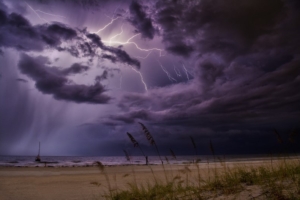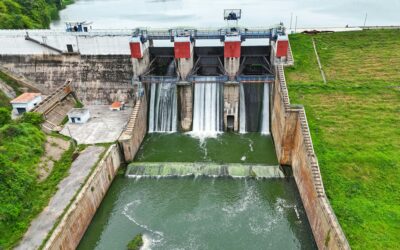It is that time of year again – hurricane season! Unfortunately, natural disasters are becoming more frequent and more destructive. Within the last couple of decades, the U.S. has faced a dramatic rise in the number of weather-related disasters and the cost of damages has exceeded $1 billion.
Throughout the 2000s, the country experienced an average of just under $7 billion disasters per year. However, now over the last five years—from 2017 to 2022—that number has increased to 18 per year and the costs are much higher. Data from last year typified the trend. The 18 natural disasters that impacted various parts of the country in 2022 caused a combined $175.2 billion in damages. And as of January 2023, 88.5% of all counties in America have declared a natural disaster over the last 10 years.
As June 1 approaches and heralds the beginning of what will likely be another turbulent disaster season, public officials are already inventorying resources and reviewing plans for emergency management. In most cases, disaster preparedness and recovery efforts will depend on intensive intergovernmental coordination as well as unique contracting opportunities for private sector companies.

The president can declare any kind of natural event to be a major disaster, provided it causes enough damage to outweigh state and local response resources. The list of potential major disasters includes, but is not limited to, tornadoes, hurricanes, severe storms, mudslides, snowstorms, droughts, tsunamis, volcanic eruptions, floods, earthquakes, and fires. The law states that when disasters occur the affected state and local governments must perform initial damage assessments. Using the findings, state officials then must request a joint Preliminary Damage Assessment from the Federal Emergency Management Agency’s (FEMA) regional office. A formal request for a disaster declaration must be made by the governor of a state.
Once a presidential declaration is made, the affected state and localities become eligible for FEMA Public Assistance (PA) grants. The grant funding usually covers 75% of costs associated with recovery work. The state is expected to cover the rest, but the 25% state match requirement can be waived or reduced in instances of extreme devastation.
On May 18, a presidential disaster declaration opened FEMA funding up to more than 40 counties in Tennessee recovering from severe storms, straight-line winds and a tornado that affected the region. On that same day, FEMA awarded another $40 million in funding to localities in Florida for debris removal work stemming from Hurricane Ian, which was a presidentially declared disaster that impacted the area in September 2022.
State governments that receive FEMA funding are subject to less stringent federal oversight, but they are required to follow the same procurement procedures that are mandated for other public solicitations. That includes a requirement to show that small and minority businesses are awarded part of the contract awards when possible.
Non-state entities, specifically at the local level of government, can also receive aid from FEMA’s Community Disaster Loan program to cover substantial losses resulting from a disaster. These loans ensure that local officials can continue governmental functions when disasters affect essential services. To qualify for the five-year loans (which can be extended to ten years), it must be shown that the disaster resulted in more than a 5% loss of local revenues for that year or the following year because of the disaster.
States also have emergency management strategies and emergency procurement policies in place. In most cases, state officials appropriate funding for a disaster emergency fund. This revenue is generally reserved for disaster recovery work and/or match funding for FEMA grants.
Emergency management is a major priority in Texas, which has been impacted by 84 natural disasters costing roughly $225 billion in damages over the last ten years. In fact, the state was recently ranked as the most at-risk state in the U.S. for billion-dollar climate disasters. The Texas Division of Emergency Management (TDEM) has broad oversight of the state’s strategy for mitigating and responding to hazards. TDEM works with local communities to provide funding, training and planning assistance for disasters.
In the city of Austin, the municipality’s Office of Homeland Security and Emergency Management (HSEM) oversees emergency responsibilities. During area-wide emergencies, HSEM is authorized to use the Austin/Travis County Emergency Operations Center. Officials coordinate response and recovery operations from that location. From this base of operations, HSEM then collaborates with representatives from regional organizations and other municipal departments to plan recovery projects.
The state of California’s emergency management plan revolves entirely around networks of local coordination that can be mobilized quickly. If the natural disaster event escalates and starts to affect additional mutual aid regions, resources and personnel from their constituent localities also become activated for wider-scale response efforts. According to the FEMA concept, disaster response efforts in California are activated in a progressive and ascending fashion. This is to say, when a disaster impacts a single local government, the response is organized locally. Yet as a disaster escalates and its impacts become more widespread, response efforts are mobilized for the encompassing operational area. When necessary, this progressive mobilization can continue to expand from an operational area to the regional level and ultimately to the entire state.
Pennsylvania, which is ranked as the 12th most at-risk state for billion-dollar climate disasters, organizes disaster recovery efforts through the Pennsylvania Emergency Management Agency (PEMA). Additionally, all county and local governments are required to have an emergency operations center capable of providing coordination of all disaster recovery efforts.
Beyond FEMA and state support, additional funding programs are also becoming available for areas affected by catastrophic weather events. Earlier this month, the Federal Highway Administration awarded $749 million across 39 states to repair roads and bridges damaged because of presidentially declared disasters. In addition, the U.S. Small Business Administration’s Office of Disaster Assistance offers low-interest, long-term loans to businesses and not-for-profit organizations of all sizes that have been affected by major disasters.
With hurricane season only days away, companies interested in being able to assist if a disaster should occur should get positioned with FEMA and local emergency management directors at the state and local levels of government. Most local cities and counties have already named emergency management directors and information about pre-qualifying for procurement-related opportunities will be available. FEMA also has several ways that companies can pre-qualify for contracting opportunities. And, many emergency-related products and equipment are procured by FEMA so that they are available regionally throughout the country. When disasters occur, citizens are best protected through collaboration between public and private sector partners and the goal is to initiate the response as quickly as possible. Being pre-qualified for whatever a private sector firm can provide is advised.






